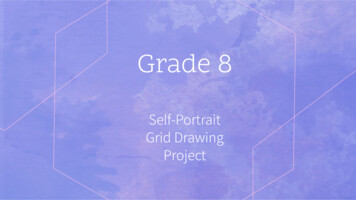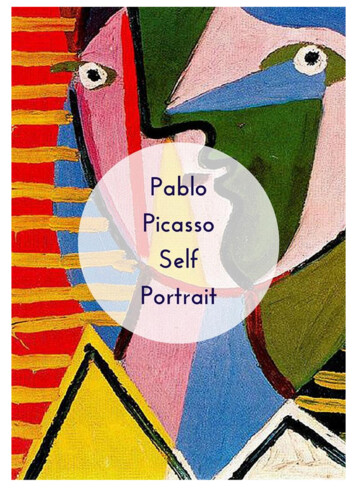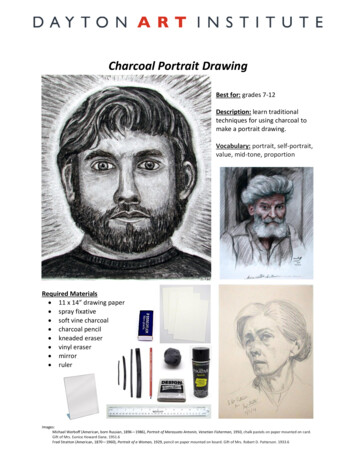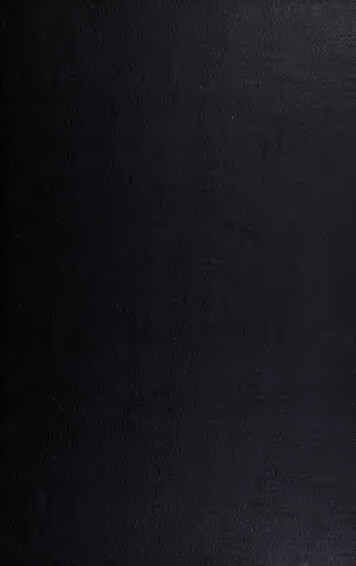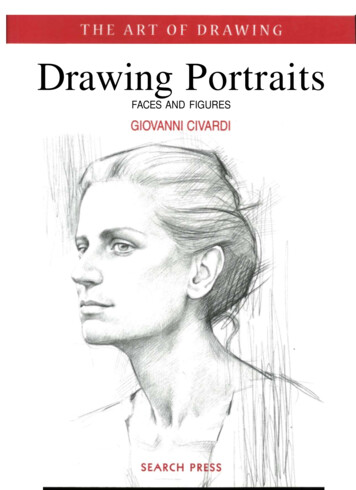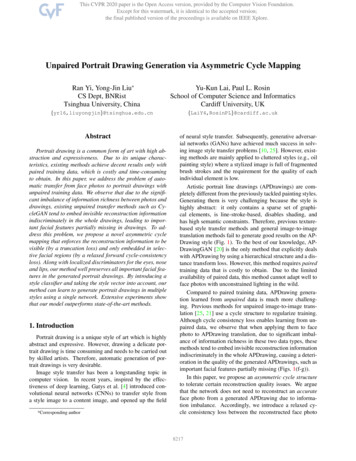
Transcription
Unpaired Portrait Drawing Generation via Asymmetric Cycle MappingRan Yi, Yong-Jin Liu CS Dept, BNRistTsinghua University, ChinaYu-Kun Lai, Paul L. RosinSchool of Computer Science and InformaticsCardiff University, @cardiff.ac.ukAbstractPortrait drawing is a common form of art with high abstraction and expressiveness. Due to its unique characteristics, existing methods achieve decent results only withpaired training data, which is costly and time-consumingto obtain. In this paper, we address the problem of automatic transfer from face photos to portrait drawings withunpaired training data. We observe that due to the significant imbalance of information richness between photos anddrawings, existing unpaired transfer methods such as CycleGAN tend to embed invisible reconstruction informationindiscriminately in the whole drawings, leading to important facial features partially missing in drawings. To address this problem, we propose a novel asymmetric cyclemapping that enforces the reconstruction information to bevisible (by a truncation loss) and only embedded in selective facial regions (by a relaxed forward cycle-consistencyloss). Along with localized discriminators for the eyes, noseand lips, our method well preserves all important facial features in the generated portrait drawings. By introducing astyle classifier and taking the style vector into account, ourmethod can learn to generate portrait drawings in multiplestyles using a single network. Extensive experiments showthat our model outperforms state-of-the-art methods.1. IntroductionPortrait drawing is a unique style of art which is highlyabstract and expressive. However, drawing a delicate portrait drawing is time consuming and needs to be carried outby skilled artists. Therefore, automatic generation of portrait drawings is very desirable.Image style transfer has been a longstanding topic incomputer vision. In recent years, inspired by the effectiveness of deep learning, Gatys et al. [4] introduced convolutional neural networks (CNNs) to transfer style froma style image to a content image, and opened up the field*Corresponding authorof neural style transfer. Subsequently, generative adversarial networks (GANs) have achieved much success in solving image style transfer problems [10, 25]. However, existing methods are mainly applied to cluttered styles (e.g., oilpainting style) where a stylized image is full of fragmentedbrush strokes and the requirement for the quality of eachindividual element is low.Artistic portrait line drawings (APDrawings) are completely different from the previously tackled painting styles.Generating them is very challenging because the style ishighly abstract: it only contains a sparse set of graphical elements, is line-stroke-based, disables shading, andhas high semantic constraints. Therefore, previous texturebased style transfer methods and general image-to-imagetranslation methods fail to generate good results on the APDrawing style (Fig. 1). To the best of our knowledge, APDrawingGAN [20] is the only method that explicitly dealswith APDrawing by using a hierarchical structure and a distance transform loss. However, this method requires pairedtraining data that is costly to obtain. Due to the limitedavailability of paired data, this method cannot adapt well toface photos with unconstrained lighting in the wild.Compared to paired training data, APDrawing generation learned from unpaired data is much more challenging. Previous methods for unpaired image-to-image translation [25, 21] use a cycle structure to regularize training.Although cycle consistency loss enables learning from unpaired data, we observe that when applying them to facephoto to APDrawing translation, due to significant imbalance of information richness in these two data types, thesemethods tend to embed invisible reconstruction informationindiscriminately in the whole APDrawing, causing a deterioration in the quality of the generated APDrawings, such asimportant facial features partially missing (Figs. 1(f-g)).In this paper, we propose an asymmetric cycle structureto tolerate certain reconstruction quality issues. We arguethat the network does not need to reconstruct an accurateface photo from a generated APDrawing due to information imbalance. Accordingly, we introduce a relaxed cycle consistency loss between the reconstructed face photo8217
(a) Input(f) DualGAN(b) Gatys et al.(c)Linear Style Transfer(d) MUNIT(g) CycleGAN(h) UNIT(i) APDrawingGAN(e1) ComboGAN (style1) (e2) ComboGAN(style2) (e3) ComboGAN(style3)(j1) Ours (style1)(j2) Ours (style2)(j3) Ours (style3)Figure 1. Comparison with state-of-the-art methods: (a) input face photo; (b)-(c) style transfer methods: Gatys [4] and Linear StyleTransfer [14]; (f)-(h) single-modal image-to-image translation methods: DualGAN [21], CycleGAN [25], UNIT [15]; (d)-(e) multi-modalimage-to-image translation methods MUNIT [9] and ComboGAN [1]; (i) a portrait generation method APDrawingGAN [20]; (j) ourmethod. Note that APDrawingGAN requires paired data for training, so unlike other work, it is trained using the paired APDrawingdataset. Due to this essential difference, we do not compare with this method in the follow-up evaluation.and the input photo. By doing so the unnecessarily detailedphoto information does not need to be fully embedded inAPDrawings. Along with localized discriminators for theeyes, nose and lips, our method can generate high-qualityAPDrawings in which all important facial features are preserved.Learning from unpaired data makes our method able toutilize APDrawings from web data for training and includemore challenging photos into the training set. To exploitthe natural diversity of styles from web training images (seeFig. 2 for some examples), our method1 further learns APDrawings in multiple styles from mixed web data and cancontrol the output style using a simple style code.The main contributions of our work are: We propose a novel asymmetric cycle-structure GANmodel to avoid indiscriminately embedding reconstruction information in the whole APDrawing that isoften caused by cycle consistency loss. We use multiple local discriminators to enforce the existence and ensure quality for facial feature drawing. We learn multi-style APDrawings from unpaired,mixed web data such that the user can switch betweenmultiple styles using a simple style code.features from images and achieve style transfer by optimizing an image such that it maintains the content from thecontent image and matches the style features from the styleimage, where the Gram matrix is used to measure style similarity. This method opens up the field of neural style transfer and many follow-up methods are proposed based on this.Li and Wand [13] proposed to maintain local patternsby using a Markov Random Field (MRF) regularizer instead of Gram matrix to model the style, and combinedMRF with CNN to synthesize stylized images. To speed upthe slow optimization process of [4], some methods (e.g.,[11, 17]) use a feed-forward neural network to replace theoptimization process and minimize the same objective function. However, these methods still suffer from the problemthat each model is restricted to a single style. To speedup optimization and allow style flexibility as [4], Huangand Belongie [8] proposed adaptive instance normalization(AdaIN) to align the mean and variance of content featuresto those of style features. In these example-guided styletransfer methods, the style is extracted from a single image,which is not as convincing as learning from a set of imagesto synthesize style (refer to Section 2.2). Moreover, thesemethods model style as texture, and thus are not suitablefor our portrait line drawing style that has little texture.2.2. GAN-based image-to-image translation2. Related Work2.1. Neural Style TransferThe power of CNNs has been validated by many visualperception tasks. Inspired by this, Gatys et al. [4] proposedto use a pretrained CNN to extract content features and style1 The code is available at ingGANs [5] have achieved much progress in many computer vision tasks, including image super-resolution [12],text-to-image synthesis [16, 22], facial attribute manipulation [23], etc. Among these works, two unified GANframeworks, Pix2Pix [10] and CycleGAN [25], have enabled much progress in image-to-image translation.Pix2Pix [10] was the first general image-to-image translation framework based on conditional GANs, and was later8218
Input Face Photo(a) Style 1(b) Style 2(c) Style 3Figure 2. We select three representative styles in our collected webportrait line drawing data. The first style is from Yann Legendreand Charles Burns where parallel lines are used to draw shadows.The second style is from Kathryn Rathke where few dark regionsare used and facial features are drawn using simple flowing lines.The third style is from vectorportal.com where continuous thicklines and large dark regions are utilized.extended to high-resolution image synthesis [18]. Moreworks focus on learning from unpaired data, due to thedifficulty of obtaining paired images in two domains. Apopular and important observation is the cycle consistencyconstraint, which is the core of CycleGAN [25] and DualGAN [21]. The cycle consistency constraint enforces thatthe two mappings from domains A to B and from B to Awhen applied consecutively to an image revert the imageback to itself. Different from enforcing cycle consistency atthe image level, UNIT [15] tackles the problem by a sharedlatent space assumption and enforcing a feature-level cycleconsistency. These methods work well for general imageto-image translation tasks. However, in face photo to APDrawing translation, cycle consistency constraints lead tofacial features partially missing in APDrawings, becausethe information between the source and target domains isimbalanced. In this paper, we relax the cycle consistencyin the forward (photo drawing photo) cycle and propose additional constraints to avoid this problem. The NIR(near infrared)-to-RGB method in [3] adopts a very different type of asymmetry: it uses the same loss for the forwardand backward cycles, and only changes the network complexity. Moreover, it targets a different task from ours.The aforementioned unpaired translation methods arealso limited in the diversity of translation outputs. Unpaireddata such as crawled web data often naturally containsmulti-modal distributions (i.e. inconsistent styles). Whenknowing the exact number of modes and the mode eachsample belongs to, the multi-modal image-to-image translation could be solved by treating each mode as a separatedomain and using a multi-domain translation method [1].However, in many scenarios including our problem setting,this information is not available. MUNIT [9] deals withmulti-modal image-to-image translation without knowingthe mode each sample belongs to. It encodes an image intoa domain-invariant content code and a domain-specific stylecode, and recombines the content code with the style codesampled from a target domain. Although MUNIT generatesmultiple outputs with different styles, it cannot generate satisfactory portrait line drawings with clear lines. Our archi-NonlinearmappingFigure 3. In CycleGAN, to reconstruct the input photo from generated drawings, a strict cycle-consistency loss embeds invisible reconstruction information indiscriminately in the whole drawings.A nonlinear monotonic mapping of the gray values is applied ina local region around the nose to visualize the embedded reconstruction information.tecture inserts style features into the generator and uses asoft classification loss to discriminate modes in the training data and produce multi-style outputs, generating betterAPDrawings than state-of-the-art methods.3. Our Method3.1. OverviewOur proposed method performs face photo to APDrawing translation without paired training data using a novelasymmetric cycle-structure GAN. Let P and D be the facephoto domain and the APDrawing domain, and no pairingsneed to exist between these two domains. Our model learnsa function Φ that maps from P to D using training dataS(p) {pi i 1, 2, · · · , N } P and S(d) {dj j 1, 2, · · · , M } D. N and M are the numbers of trainingphotos and APDrawings. Our model consists of two generators — a generator G transforming face photos to portraitdrawings, and an inverse generator F transforming drawings back to face photos — and two discriminators, DD responsible for discriminating generated drawings from realdrawings, and DP responsible for discriminating generatedphotos from real photos.The information in the APDrawing domain is much lessthan in the face photo domain. For example, in the cheekregion, there are many color variations in the original photobut the cheek is usually drawn completely white (i.e. nolines are included) in an APDrawing. Enforcing a strictcycle-consistency loss like in CycleGAN [25] on the reconstructed face photo and the input photo will cause thenetwork to embed reconstruction information in very smallvariations in the generated APDrawings (i.e., color changesthat are invisible to the eye but can make a differencein network calculation) [2]. See Fig. 3 for an example.Embedding reconstruction information in very small variations achieves a balance between cycle-consistency lossand GAN loss in CycleGAN; the generated drawing G(p)8219
can successfully reconstruct a face photo similar to the input photo because of small color changes, while at the sametime G(p) can be similar to real drawings and be classifiedas real by the discriminator. Embedding invisible reconstruction information indiscriminately in the whole drawingwill put a very strong restriction on the objective functionoptimization. Moreover, it will allow important facial features to be partially missing in the generated drawings.We observe that although cycle consistency constraintsare useful to regularize training, we are only interested inthe one way mapping from photos to portrait drawings.Therefore, different from CycleGAN, we do not expect orrequire the inverse generator F to reconstruct a face photoexactly as the input photo (which is a near impossible task).Instead, our proposed model is asymmetric in that we usea relaxed cycle-consistency loss between F (G(p)) and p,where only edge information is enforced to be similar, whilea strict cycle-consistency loss is enforced on G(F (d)) andd. By tolerating the reconstruction information loss between F (G(p)) and p, the objective function optimizationhas enough flexibility to recover all important facial featuresin APDrawings. A truncation loss is further proposed toenforce the embedded information to be visible, especiallyaround the local area of the selected edges where relaxedcycle-consistency loss works. Furthermore, local drawingdiscriminators for the nose, eyes and lips are introduced toenforce their existence and ensure quality for these regionsin the generated drawings. By using these techniques, ourmethod generates high-quality portrait line drawings withcomplete facial features.Our model also deals with multi-style APDrawing generation. The APDrawing data we collected from the Internet contains a variety of styles, of which only some aretagged with author/source information. We select representative styles from the collected data (see Fig. 2), and train aclassifier for the collected drawings. Then a learned representation is extracted as a style feature and inserted into thegenerator to control the generated drawing style. An additional style loss is introduced to optimize for each style.The four networks in our model are trained in an adversarial manner [5]: the two discriminators DD andDP are trained to maximize the probability of assigning correct labels to real and synthesized drawings andphotos; and meanwhile the two generators G and Fare trained to minimize the probability of the discriminators assigning the correct labels. The loss functionL(G, F, DD , DP ) contains five types of loss terms: adversarial loss Ladv (G, DD ) Ladv (F, DP ), relaxed cycle consistency loss Lrelaxed cyc (G, F ), strict cycle consistencyloss Lstrict cyc (G, F ), truncation loss Ltrunc (G, F ), andstyle loss Lstyle (G, DD ). Then the function Φ is optimized by solving the minimax problem with loss functionL(G, F, DD , DP ):min max L(G, F, DD , DP )G,F DD ,DP (Ladv (G, DD ) Ladv (F, DP )) λ1 Lrelaxed cyc (G, F ) λ2 Lstrict cyc (G, F ) λ3 Ltrunc (G, F ) λ4 Lstyle (G, DD )(1)In Section 3.2, we introduce the architectures of ourmodel and our different designs for G, DD and F, DP . InSection 3.3, we introduce our asymmetric cycle-consistencyrequirements and five loss terms. An overview of ourmethod is illustrated in Fig. 4.3.2. ArchitectureOur GAN model consists of a generator G and a discriminator DD for face photo to drawing translation, andanother generator F and discriminator DP for the inversedrawing to photo translation. Considering information imbalance between the face photo in P and the APDrawing inD, we design different architectures for G, DD and F, DP .3.2.1Face photo to drawing generator GThe generator G takes a face photo p and a style feature sas input, and outputs a portrait line drawing G(p, s) whosestyle is specified by s.Style feature s. We first train a classifier C (basedon VGG19) that classifies portrait line drawings into threestyles (Fig. 2), using tagged web drawing data. Then weextract the output of the last fully-connected layer and usea softmax layer to calculate a 3-dimensional vector as thestyle feature for each drawing (including untagged ones).Network structure. G is an encoder-decoder with residual blocks [7] in the middle. It starts with a flat convolutionand two down convolution blocks to encode face photos andextract useful features. Then the style feature is mapped toa 3-channel feature map and inserted into the network byconcatenating it with the feature map of the second downconvolution block. An additional flat convolution is used tomerge the style feature map with the extracted feature map.Afterwards, nine residual blocks of the same structure areused to construct the content feature and transfer it to thetarget domain. Then the output drawing is reconstructed bytwo up convolution blocks and a final convolution layer.3.2.2Drawing discriminator DDThe drawing discriminator DD has two tasks: 1) to discriminate generated portrait line drawings from real ones; and2) to classify a drawing into three selected styles, where areal drawing d is expected to be classified into the correctstyle label (given by C), and a generated drawing G(p, s)is expected to be classified into the style specified by the3-dimensional style feature s.8220
Relaxed cycle-consistency lossHEDHEDLPIPSTruncation lossTruncGenerator 𝐹Generator 𝐺Generated drawing 𝐺(𝑝, 𝑠)Input photo 𝑝Style feature 𝑠𝑫𝓓 {𝐷, 𝐷 , , 𝐷 - , 𝐷 } Discriminator𝐷Style lossInput drawing 𝑑Style classificationReconstruction 𝐹(𝐺 𝑝, 𝑠 )Nose Discrim𝐷 ,Real / FakeEye Discrim𝐷 -Adversarial lossGenerated photo 𝐹(𝑑)Reconstruction 𝐺(𝐹 𝑑 , 𝑠)Generator 𝐹Adversarial lossLip Discrim𝐷 Generator 𝐺Discriminator𝐷𝒫Style feature 𝑠Real / FakeStrict cycle-consistency lossFigure 4. Our model is an asymmetric cycle-structure GAN model that consists of a photo to drawing generator G, a drawing to photogenerator F , a drawing discriminator DD and a photo discriminator DP . We use a relaxed cycle-consistency loss between reconstructedface photo F (G(p)) and input photo p, while enforcing a strict cycle-consistency loss between reconstructed drawing G(F (d)) and inputdrawing d. We further introduce local drawing discriminators Dln , Dle , Dll for the nose, eyes and lips and a truncation loss. Our modeldeals with multi-style generation by inserting a style feature into the generator and adding a style loss.For the first task, to enforce the existence of importantfacial features in the generated drawing, besides a discriminator D that analyzes the full drawing, we add three local discriminators Dln , Dle , Dll to focus on discriminatingthe nose drawing, eye drawing and lip drawing respectively.The inputs to these local discriminators are masked drawings, where masks are obtained from a face parsing network [6]. DD consists of D, Dln , Dle , Dll .Network structure. The global discriminator D is basedon PatchGAN [10] and modified to have two branches. Thetwo branches share three down convolution blocks. Thenone branch Drf includes two flat convolution blocks to output a prediction map of real/fake for each patch in the drawing. And the other classification branch Dcls includes moredown convolution blocks and outputs probability values forthe three style labels. Local discriminators Dln , Dle , Dllalso adopt the PatchGAN structure.3.2.33.3. Loss FunctionsThere are five types of losses in our loss function (Eq.(1)). We explain them in detail as follows:Adversarial loss. The adversarial loss judges discriminator DD ’s ability to assign correct labels to real and synthesized drawings. It is formulated as:XLadv (G, DD ) Ed S(d) [log D(d)]D DD (2)Ep S(p) [log(1 D(G(p, s))]D DDwhere s is randomly selected from the style features ofdrawings in S(d) for each p. As DD maximizes this lossand G minimizes it, this loss drives the generated drawingsto become closer to real drawings.We also adopt an adversarial loss for the photo discriminator DP and the inverse mapping F :Drawing to face photo generator F and Photodiscriminator DPThe generator F in the inverse direction takes a portrait linedrawing d as input and outputs a face photo F (d). It adoptsan encoder-decoder architecture with nine residual blocksin the middle. Photo discriminator DP discriminates generated face photos from real ones, and also adopts the PatchGAN structure.XLadv (F, DP ) Ep S(p) [log DP (p)] Ed S(d) [log(1 DP (F (d))](3)Relaxed forward cycle-consistency loss. As aforementioned, we observe that there is much less information indomain D than information in domain P. We do not expect p G(p, s) F (G(p, s)) to be pixel-wise similar to p. Instead, we only expect the edge information in8221
p and F (G(p, s)) to be similar. We extract edges from pand F (G(p, s)) using HED [19], and evaluate the similarityof edges by the LPIPS perceptual metric proposed in [24].Denote HED by H and the perceptual metric by Llpips , therelaxed cycle-consistency loss is formulated as:Lrelaxed cyc (G, F ) Ep S(p) [Llpips (H(p), H(F (G(p, s))))](4)Strict backward cycle-consistency loss. On the otherhand, the information in the generated face photo is adequate to reconstruct the drawing. Therefore, we expectd F (d) G(F (d), s(d)) to be pixel-wise similar tod, here the style feature s(d) is the style feature of d. The(a) Input Content(b) Input Style(c) Gatys(d) LinearStyleTransfer (e) Ours(style1,2,3)strict cycle-consistency loss in the backward cycle is thenFigure 5. Comparison with two state-of-the-art neural style transformulated as:Lstrict cyc (G, F ) Ed S(d) [ d G(F (d), s(d)) 1 ](5)Truncation loss. The truncation loss is designed toprevent the generated drawing from hiding information insmall values. It is in the same format as the relaxed cycleconsistency loss, except that the generated drawing G(p, s)is first truncated to 6 bits (a general digital image stores intensity in 8 bits) to ensure encoded information is clearlyvisible, and then fed into F to reconstruct the photo. Denote the truncation operation as T [·], the truncation loss isformulated as:Ltrunc (G, F ) Ep S(p) [Llpips (H(p), H(F (T [G(p, s)])))](6)In the first period of training, the weight for the truncationloss is kept low, otherwise it would be too hard for the modelto optimize. The weight gradually increases as the trainingprogresses.Style loss. The style loss is introduced to help G generate multiple styles with different style features. Denote theclassification branch in DD as Dcls , the style loss is formulated asXLcls (G, DD ) Ed S(d) [ p(c) log Dcls (c d)]c Ep S(p) [ Xp′ (c) log Dcls (c G(p, s))]c(7)For real drawing d, p(c) is the probability over style labelc given by classifier C, Dcls (c d) is the predicted softmaxprobability by Dcls over c. We multiply by the probabilityp(c) in order to take into account those real drawings thatmay not belong to a single style but lie between two styles,e.g. softmax probability [0.58, 0.40, 0.02]. For generateddrawing G(p, s), p′ (c) denotes the probability over style label c and is specified by style feature s, Dcls (c G(p, s)) isthe predicted softmax probability over c. This classificationloss drives Dcls to classify a drawing into the correct styleand drives G to generate a drawing close to a given stylefeature.fer methods, i.e., Gatys [4] and LinearStyleTransfer [14].4. ExperimentsWe implemented our method in PyTorch. All experiments are performed on a computer with a Titan Xp GPU.The parameters in Eq. 1 are λ1 5 4.5in , λ2 5,λ3 4.5i,λ 1,whereiisthecurrentepochnumber,4nand n is the total epoch number.4.1. Experiment SetupData. We collect face photos and APDrawings from theInternet and construct a training corpus of 798 face photos and 625 delicate portrait line drawings, and a test set of154 face photos. Among the collected drawings, 84 are labeled with artist Charles Burns, 48 are labeled with artistYann Legendre, 88 are labeled with artist Kathryn Rathke,212 are from website vectorportral.com, while others haveno tagged author/source information. We observed thatboth Charles Burns and Yann Legendre use similar parallellines to draw shadows, and so we merged drawings of thesetwo artists into style1. We select the drawings of KathrynRathke as style2 and the drawings of vectorportral as style3.Both of them have distinctive features: Kathryn Rathke usesflowing lines but few dark regions and vectorportral usesthick lines and large dark regions. All the training imagesare resized and cropped to 512 512 pixels.Training process. 1) Training classifier C. We firsttrain a style classifier C (Section 3.2.1) with the taggeddrawings and data augmentation (including random rotation, translation and scaling). To balance the number ofdrawings in each style, we take all drawings from the firstand second styles but only part of the third style in training stage of C, to achieve more balanced training for different styles. 2) Training our model. Then we use thetrained classifier to obtain style features for all 625 drawings. We further augment training data using synthesizeddrawings. Training our network with the mixed data of realdrawings and synthesized drawings results in high-qualitygeneration for all three styles (Figs. 5-7, where our results8222
(a) Input(b) DualGAN(c) CycleGAN(d) UNIT(e) Ours(style1) (f) Ours(style2) (g) Ours(style3)Figure 6. Comparison with three single-modal unpaired image-to-image translation methods: DualGAN [21], CycleGAN [25], UNIT [15].(a) Input(b) MUNIT(c) ComboGAN (style1, 2, 3)(d) Ours (style1, 2, 3)Figure 7. Comparison with two unpaired image-to-image translation methods that can deal with multi-modal or multi-domain translation:MUNIT [9], ComboGAN [1].of styles 1, 2, 3 are generated by feeding in a style featureof [1, 0, 0], [0, 1, 0], [0, 0, 1] respectively).4.2. ComparisonsWe compare our method with two state-of-the-art neuralstyle transfer methods: Gatys [4], LinearStyleTransfer [14],and five unpaired image-to-image translation methods: DualGAN [21], CycleGAN [25], UNIT [15], MUNIT [9] andComboGAN [1].Comparisons with neural style transfer methods areshown in Fig. 5. Gatys’ method fails to capture portrait linedrawing styles because it uses the Gram matrix to modelstyle as texture and APDrawings have little texture. LinearStyleTransfer produces visually better results but still notthe desired line drawing: the generated drawings have manythick lines but they are produced in a rough manner. Compared to these example-guided style transfer methods, ourmethod learns from a set of APDrawings and generates delicate results for all three styles.Comparisons with single-modal unpaired image-toimage translation methods are shown in Fig. 6. DualGANand CycleGAN are both based on strict cycle-consistencyloss. This causes a dilemma in photo to line drawing translation: either a generated drawing looks like a real drawing(i.e. close to binary, containing large uniform regions) butcannot properly reconstruct the original photo; or a generated drawing has grayscale changes and good reconstruction but does not look like a real drawing. Also, comparedto CycleGAN, DualGAN is more grayscale-like, less abstract and worse in line drawing style. UNIT adopts featurelevel cycle-consistency loss, which makes the results lessconstrained at the image level, making the face appear deformed. In comparison, our results both preserve face structure and have good image and line quality.Comparisons with unpaired image-to-image translationmethods that can deal with multi-modal or multi-domaintranslation are shown in Fig. 7. Results show that MUNITdoes not capture the line drawing style in our task and the results are more similar to a pencil drawing with shading andmany gray regions. ComboGAN fails to capture all threerepresentative styles and performs better on styles 2 and 3than style 1. Our architecture inserts style information earlier in the generator, which gives more space for multi-stylegeneration. As a result, our method generates distinctive re-8223
evaluation (FID evaluation) in the supplementary material.4.4. Ablation Study(a) Input(b) w/o ℒ𝑟𝑒𝑙𝑎𝑥𝑒𝑑 (c) w/o ℒ𝑟𝑒𝑙𝑎𝑥𝑒𝑑w/o 𝐷𝑙 (d) w/o 𝐷𝑙 (e) w/o HED(f) OursFigure 8. Ablation study: (a) input photos, (b) results of removing relaxed cycle-consistency loss (i.e. using L1 loss) and removing local discriminators, (c) results of removing relaxed cycleconsistency loss, (d) results of removing local discriminators,
Portrait drawing is a unique style of art which is highly abstract and expressive. However, drawing a delicate por-trait drawing is time consuming and needs to be carried out by skilled artists. Therefore, automatic generation of por-trait drawings is very desirable. Image style t

